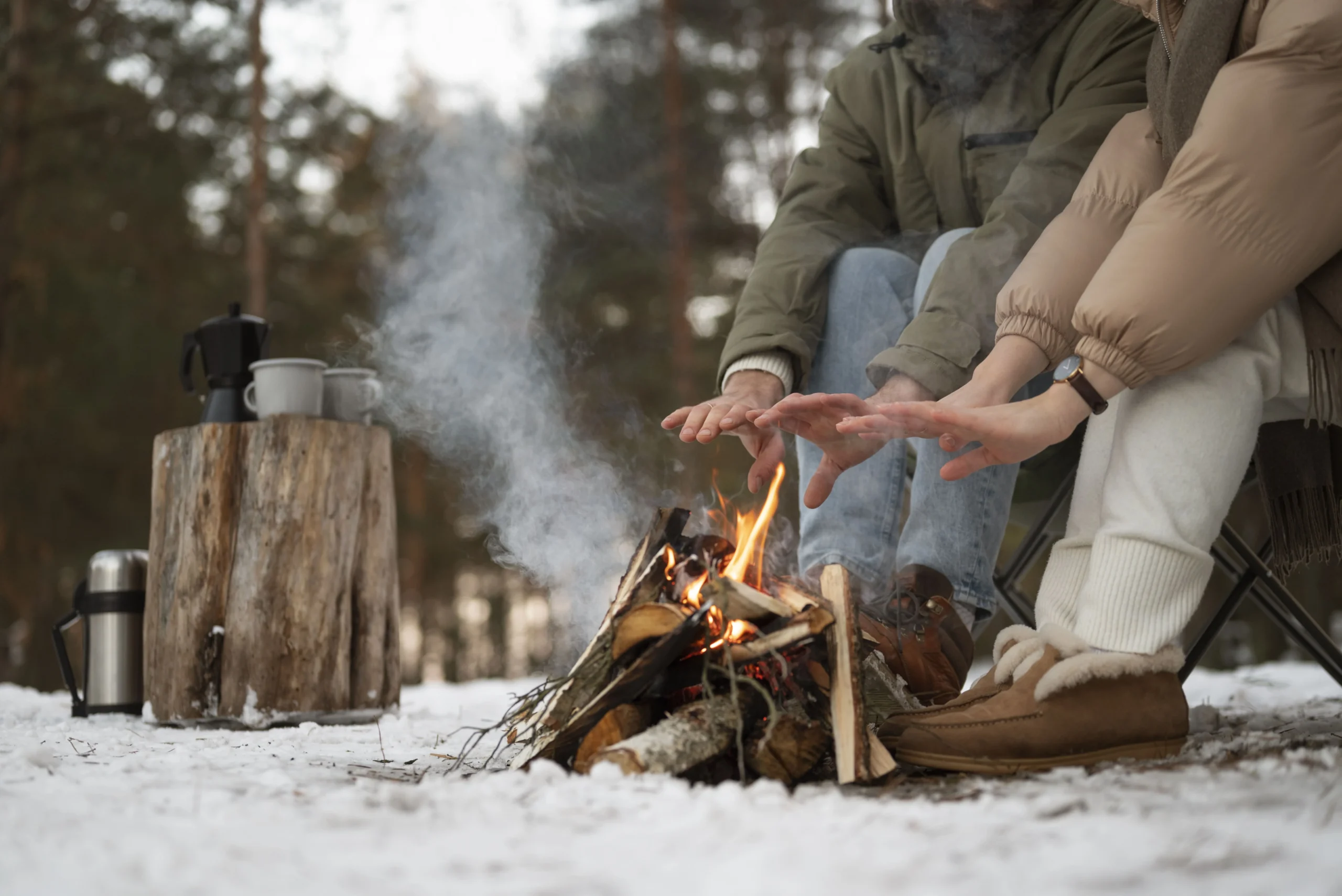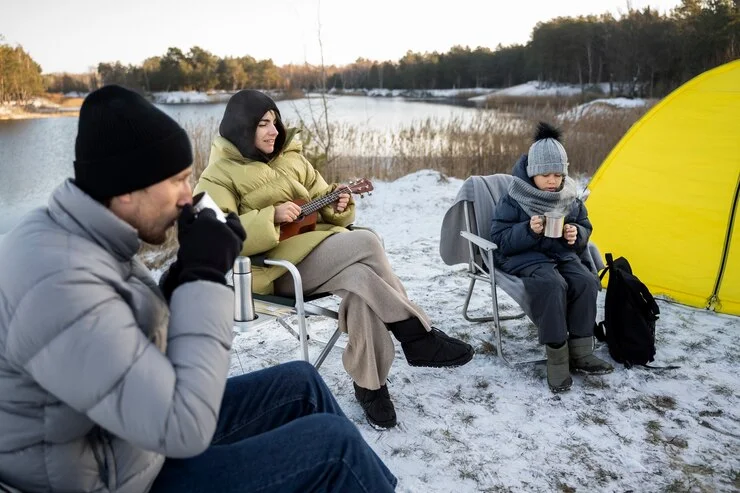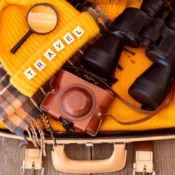Winter camping is the best for everyone those who love adventurous and want to enjoy the snowy days. It can be a beautiful adventure with lots of snow, very fresh air, and no people anywhere – at least that is how it might turn out sometimes. Nevertheless, there are difficulties, especially, on how to warm themselves up during the freezing period. In fact, failure to prepare is depriving your winter camping experience not only of being fun but also safe. Below are the top 10 camping strategies that will be useful during your winter camping escapade:
Choose the Right Campsite
Location Matters in Winter Camping
Winter camping: the location is the most important thing you should not joke with. A good site offers some protection from the climate while a bad one will have you shivering in the wind whilst temperatures drop rapidly. Choose a location where there is low wind factor by checking whether there are trees, rocks or hills that can protect the whole area.
Avoid Low-Lying Areas
Cold air and moisture gather in low lands hence it is advisable not to set camp in the areas. Cold air is heavier than a warm air and hence it tends to settled at a lower level; it becomes even colder in valleys or depressions. It is good to locate away from low bottoms, but the area should not be on the exposed ridge as the wind becomes a big factor.
Invest in a High-Quality Four-Season Tent
The Importance of a Cold-Weather Tent
To some extend the specification of a Cold-weather tent is going to roof you against all the unfortunate events of a cold weather season.
For the winter camp it is necessary to have a reliable four-seasons tent. These tents utilize materials that are especially made for areas with heavy snow loads and powerful gusts of wind so you are shielded from storms. They also have better ventilation than three season tents, and this is because they provide insulation to the body heat.
Proper Tent Setup for Insulation
For even more insulation, use a ground tarp so that water can’t penetrate through the bottom of the tent. Tent should be well anchored to the grounds; ensure the edges of the tent are sealed with snow so that there is no liberal flow of draughts. Further, if your tent has some ventilation points make sure to open them, this is because condensation might buildup in the tent and since the temperature outside is already extremely low it may freeze within the tent.
Layer Your Sleeping System

Choosing the Right Sleeping Bag
Sleeping bags are its shield from the cold starting with knapsack carrying convenient in technique of utilization quickly and easily. Select a sleeping bag that is comfortable with temperatures much lower than probably be met while on the trip. Down sleeping bags are light and very warm, synthetics on the other hand are better when they get soaked.
Sleeping Pads Are a Must
Just as important as warm from above is the insulation from the cold ground underneath. A sleeping pad offers insulation between you body and the cold ground A good sleeping pad should have a high R value, a measure of insulation.
Dress in Layers
Base Layer, Insulating Layer, and Outer Layer
Thus, the main rule of wearing clothes during winter is layering. Base layer: This layer consists of something that draws sweat away and keep it off your skin and could be a merino wool or even synthetic fabric. With it, layer it up with something like fleece or down to help hold in heat. It is good to wear the external clothing layer of a weatherproof and a windproof layer to protect you against the weather.
Don’t Forget Thermal Socks and Gloves
It is the extremities that start to feel cold first and that is why thermal socks, gloves, as well as a good hat should be worn. For warmth and warm and dry hands and feet Wool or synthetic material are ideal. If they get wet, it is important therefore to have a spare pair of socks to change into.
Keep Your Water from Freezing
Insulated Water Bottles and Containers
At times it can freeze fast, and this means that you will be without this very important supply especially if it is in sub-zero temperatures. Some insulated water bottles will not allow the water to freeze, besides, keeping the bottles inside the tent or sleeping bag will also help. One should not take plastic bottles because they become so rigid causing them to crack in cold temperatures.
Melt Snow for Water
Consequently, if your supply of water is scarce, there is no better way of preserving your body than by melting snow. Heat snow in a pot using a camping stove must be aware that you will not get much water since most of the snow is mostly air. It is also appropriate to boil the water and if that is not feasible use water purification tablets to help filter the water.
Use Hand Warmers and Hot Water Bottles
Portable Heat Sources
Chemical hand warmers or even the reusable gel packs can help provide a much-needed warmth in Freezing temperatures(decimal-20). Just put them in your gloves or pocket, or sleeping bag and you will never sweat at night. They can be folded and slid in the pocket and they come in handy especially if camping during the winter.
Campfire Safety Tips
Although getting warmth is good when putting up a campfire in snowy areas be careful not to cause an accident. Thoroughly clear a space of snow and gather rocks to make a circle so the fire will not spread. Control the fire at all times and more importantly never leave it alone. You also want to make sure that the fire is completely out before retiring to bed.
Eat High-Calorie Foods
Fuel Your Body to Stay Warm
Warmer temperatures cause the metabolism to slow down, which means your body requires more energy to maintaining warmth and you’ll need to fuel up with high calorie foods. For nutrients that can help provide the energy you need for the day, concentrate on fats, proteins and carbohydrates. The high-energy snacks include nuts, cheese, and dried meat.
Warm Meals and Hot Drinks
Have foods with lots of vitamins, energy, and warm foods like soups, casseroles, or pasta meals. Beverages such as tea, coffee, or cocoa are equally good because, apart from warming you up, they make for good drinks. Certify that you have sufficient food for the period of the trip in a case where you are incapable to find rather to eat.
Stay Dry to Stay Warm

Moisture is Your Enemy in Cold Weather
The first general rule of winter camping is to remain as dry as possible. When one is exposed to severe cold, wet clothes and gears are a very real danger – hypothermia can result. In the case you wore any damp clothes, do change out of them as soon as possible, and keep your sleeping gear in dry bags.
Use Waterproof Gear
Ensure that you buy jackets, pants and boots that are water proof so that you do not get wet. Other areas that you can be protected include the gaiters especially if you are hiking in a snowy area, you will find that gaiters will help keep the snow from filling your boots. It also helps you to avoid getting soaked by rain or snow or so frozen in wintertime.
Keep Moving
Stay Active to Generate Heat
Another good idea is to keep active because this warms one up and helps to avoid feeling cold. Spend short periods of time outdoors moving – for example, take short hikes or do exercises to get your blood flowing or collect firewood for the evening’s campfire. But do not get too sweaty because sweat causes wetting of clothes and hence results to quick evaporation.
Know the Warning Signs of Hypothermia

Recognize the Symptoms
Hypothermia is a dangerous condition, which means that you lose heat while your body cannot create it. Initial sign is shaking, followed by drowsiness, confusion, and changes in speech. In cases where hypothermia is left untreated it becomes fatal.
Prevention and Emergency Action
To avoid hypothermia, dress properly, remain dry and well fed and well hydrated at all times. If anyone has symptoms in themselves or their companions, respond immediately by layering up the person in clothes or blankets and perhaps a heater. If possible, transfer them to a warmer and protected environment and see a doctor if the wet signs get worse.
Conclusion:
Cold-weather camping can be one of the most amazing and fulfilling adventures, it’s the best of nature, untouched and still. But it is essential to know how you can protect yourself and to be warm. With the right apparel, regular exercise, proper diet, and knowledge of the risks associated with low temperatures your winter camping expedition should be fun and unforgettable. These ten tips have been proved to be efficient, you just have to follow them, and you’ll experience the joy of winter camping.







